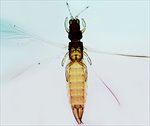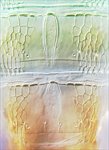Generic diagnosis
Female macropterous. Head longer than wide, strongly reticulate, not projecting in front of eyes; ocellar region elevated, occipital ridge absent, cheek constricted at base; one pair of postocular setae; maxillary palps 2-segmented. Antennae 7-segmented, segment I without paired dorso-apical setae; III and IV each with one simple sense cone. Pronotum strongly reticulate, no long setae. Mesonotum entire, reticulate, anteromedian campaniform sensilla absent. Metanotum with median setae behind anterior margin; reticulate medially, triangle present. Fore wing anterior margin fringe cilia absent, costa almost fused with first vein, veinal setae minute, second vein without setae; posterior margin fringe cilia wavy. Prosternal ferna divided; basantra membranous and without setae; mesosternum endofurca without spinula; metasternal endofurca transverse without spinula. Legs strongly reticulate, tarsi 1-segmented. Tergites with entire craspedum, II–VIII with polygonal reticulation laterally, smooth medially with a broad median longitudinal ridge; VIII without comb; IX with anterior campaniform sensilla present; X median split complete. Sternite II with reticulation on anterior half, III–VIII with reticulation only laterally; II–VII with three pairs posteromarginal setae; VII with two additional small setae.
Male sternites III–VII each with a circular to oval pore plate.
Biological data
Species of this genus apparently all breed only on grasses.
Distribution data
Recent collecting in northern Australia suggests that the number of sternal pore plates in males, and also the colour of the fore wings, is more variable than the published literature indicates (Wilson, 1975). Currently a single species of this genus is recorded from China, and this is identified as a peringueyi from Africa, but that species is very similar to longiceps that is common in Indonesia and northen Australia.
Nomenclatural data
Phibalothrips Hood, 1918: 125. Type species Phibalothrips exilis Hood, 1918, synonym of Heliothrips longiceps Karny, by monotypy.
There are four species recognised in this genus, and one of these is recorded from China:
peringueyi (Faure, 1925: 145). (Reticulothrips)
Relationship data
Thripidae sub-family Panchaetothripinae: this group is represented widely around the world, particularly in tropical areas, and comprises about 40 genera. This Old World genus shares a number of character states with the New World genus, Heliothrips (Mound et al., 2001). However, the slender body form of the species possibly reflects their association with Poaceae. As in the rather similar species of the Australian grass-living genus, Moundothrips, antennal segment IV of Phibalothrips species has presumably lost the additional simple sense cone that is normal on species of Panchaetothripinae.
References
Mound LA, Marullo R & Trueman JWH (2001) The greenhouse thrips, Heliothrips haemorrhoidalis, and its generic relationships within the sub-family Panchaetothripinae (Thysanoptera; Thripidae). Journal of Insect Systematics and Evolution 32: 1–12.
ThripsWiki (2020) ThripsWiki - providing information on the World's thrips. <http://thrips.info/wiki/Main_Page>
Wilson TH (1975) A monograph of the subfamily Panchaetothripinae (Thysanoptera: Thripidae). Memoirs of the American Entomological Institute 23: 1–354.



